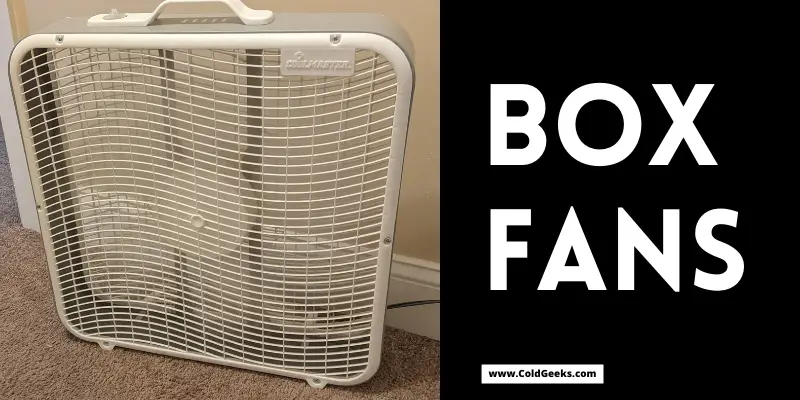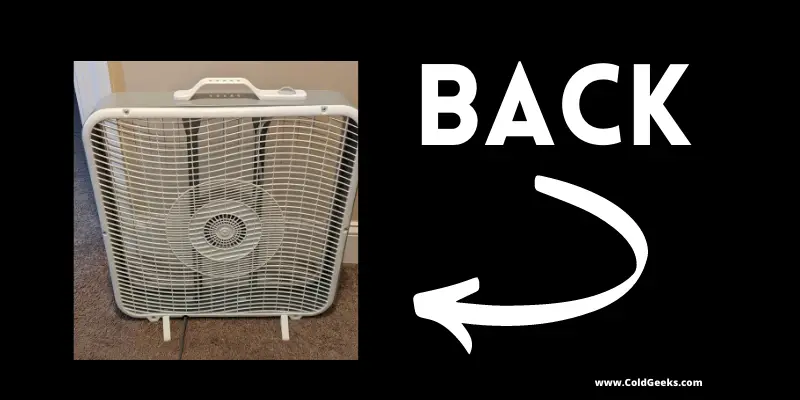Box fans are some of the most available, affordable, and popular fans all over the world.
What is a box fan?
A box fan is a fan with a box-shaped frame and a hollow chamber. They are designed for use on the floor, desk, or table in front of you. The blades of a box fan are located inside of the chamber behind a protective wire-mesh grill. The fan blades spin, blowing air out through the wire mesh.
In this article, I’ll answer the most common questions people ask me about box fans, including what they look like, what they are for, and how they are different than other fans.
What Does a Box Fan Look Like?

A box fan looks like a square or rectangular box with a motor and fan blades on the inside behind a wire mesh screen.
The image above is of one of my box fans.
Box fans come in all kinds of colors but white is very popular.
Why Is It Called a Box Fan?
These fans are named for their box-like shape.
Most fans have simple names:
- Neck fans hang around your neck
- Ceiling fans go on the ceiling
- Tower fans look like miniature towers
Box fans are designed in a square box, which makes moving and stacking them a snap.
What Size Is a Box Fan?
Box fans come in different sizes to meet your needs. You may want a box fan just for yourself, for a small room, or even for industrial purposes.
Here is a quick table to show you a range of sizes:
| Box Fan Purpose | Box Fan Size |
|---|---|
| Personal box fan | 10 X 10 inches |
| Standard box fan | 20 X 20 inches |
| Industrial box fan | 24 X 24 inches (and larger) |
Most standard-size box fans are 20 inches X 20 inches.
You can also purchase larger industrial size box fans or smaller personal box fans.
Industrial size box fans can range from 24 inches and up, making these giant machines much too powerful for most residential or office use.
Personal box fans are usually 10 X 10 inches, perfect for a desk or table.
What Are Box Fans Made Of?
A box frame is made of a combination of plastic and metal parts.
The parts that make up a typical box fan include:
- Frame—The outer part of the fan housing (usually made of plastic)
- Fan blades—The parts inside the housing that spin to move air (metal or plastic)
- Motor—The engine of the fan, which is located in the middle or back of the body (made of metal)
- Guard/Grill—A metal or plastic screen that protects the fan blades from fingers, pets, and other objects
What Is the Back of a Box Fan Called?
There is no special name for the back of a box fan. I usually just call it the “back.”
The backside of a box fan looks almost identical to the front of a box fan.

On closer inspection, you can see some slight differences in the protective grill. You’ll also notice the housing for the motor.
The fan blades are closer to the front of the box fan.
What Kind of Motor Is In a Box Fan?
Most box fans use induction motors.
Induction motors work by using a rotating magnetic field to create an electric current in the rotor. This current then creates its own magnetic field, which turns the fan blades.
Some box fans use brushless motors.
What Is the CFM of a Box Fan?
A typical 20-inch box fan has a CFM from 1,000 to 2,500.
CFM stands for Cubic Feet per Minute. CFM is the number of cubic feet of air per minute the fan moves.
The power of a fan depends on this measurement. The higher the CFM is, the more powerful the fan.
What Is The Decibel Level of a Box Fan?
A standard box fan has an average decibel (dB) rating that ranges from 55 to 65 dB.
A quiet box fan might produce a dB of between 30 to 35 (or lower).
Decibel levels are measured using a logarithmic scale to account for the ear’s sensitivity to sound. Decibel measurements only measure how loud a sound is, not the level of intensity.
What Is the Max Operating Temperature For a Box Fan?
The max operating temperature of a standard box fan is 200 Fahrenheit (F), but box fans don’t cool you when the surrounding temperature is above 95 degrees F (they just circulate the hot air).
The more budget-friendly box fans might not make it to 200 F, but the more expensive and better-built brands will get close.
Hopefully, you’ll never need to experience that kind of heat.
What Is a Box Fan For?
You can use a box fan for a variety of purposes.
Box fan uses:
- Blowing air into or pulling air out of a room (when set in a window)
- Creating white noise to help you sleep, study, or meditate
- Circulating air around a space (like a grow room)
- Providing a breeze outside on a hot day
- Cooling you down (in a kitchen, home gym, or while indoor cycling)
- Mining (computer related)
- Managing the temperature of your office or dorm room
- Deter small pests (like flies, gnats, bees, or mosquitoes)
- Dry out a room after a flood
What Is a Box Fan Not For?
Box fans are not for really large or really hot spaces. Box fans are not a good replacement for air conditioning.
Not all of these fans are designed to get wet, withstand harsh weather, or run constantly.
It’s always a good idea to check the specifications to make sure you’re getting the best fan for your needs (see my suggestions at the end of this article).
If you want to cool down a large space, you will probably need an industrial size box fan (or another type of fan altogether).
Types of Box Fans
Before you choose a box fan, it’s helpful to know the different types.
Common types of box fans include:
- Personal cooling box fans
- Box fans with weather-resistant motors
- Box fans with air-purifying filters
- Box fans with carrying handle
- Box fans with remote control
- Industrial box fans
How Is a Box Fan Different Than Other Fans?
Over the years, many people have asked me about the difference between box fans and other types of fans.
Let’s go over the most important points.
Box Fan vs Pedestal Fan
This 3-minute video goes over all of the main differences between a box fan and a pedestal fan:
A box fan sits on the floor (or sometimes a desk). The bottom of the box fan is flush with the floor (other than very thin stabilizing “legs”).
A pedestal fan is set atop a large, round base and has a pole that reaches up to the fan blades.
The moter and blades reside at the top of the pole. Therefore, a pedestal fan blows air at varying heights.
Pedestal fans also often include oscillation, so they swing back and forth for more airflow coverage.
A box fan is typically stationary with air flowing in a single direction.
Box Fan vs Ceiling Fan
A box fan generally sits on the floor, while a ceiling fan hangs from the ceiling.
A ceiling fan blows cool air down into spaces.
Box fans blow air through places. If you set a box fan in a window, it can suck hot air out of spaces.
Celing fans are typically much stronger than most box fans.
Box Fan vs Tower Fan
Box fans and tower fans both sit on the floor.
However, tower fans are usually taller and narrower, can oscillate, and offer more features (such as timers, more speed options, and air purification).
You can choose from among smart tower fans and bladeless tower fans.
Tower fans also take up less space and are generally more expensive than box fans. Depending on the tower fan, they can generate a stronger air flow or circulation.
Box Fan Brands
Here are some of the most popular brands of box fans:
- Lasko
- Optimus
- Comfort Zone
- Air King
- Black & Decker
- Genesis
- Impress
- Pelonis
- Godting
- Airfort
Are All Box Fans the Same?
All box fans share a similar design and shape, but not all box fans are the same. Nearly all box fans include three different speed settings (low, medium, and high).
Certain box fans use better materials that make them more durable.
There are fans that include space for an air purification filter and also box fans of different sizes.
Box fans also differ in aesthetic.
Some box fans simply look cleaner and nicer (usually the higher price and more powerful fans).
What Box Fan Should I Buy? (Tested & Solved)
When it comes to actually buying a box fan, take into consideration the airflow, size, durability, CFM, noise level, and price.
Check out my top recommendations for the best box fans:
| Box Fan Purpose | Best Box Fan |
|---|---|
| Best overall box fan | Pelonis |
| Quietest box fan | Black & Decker Mini Box Fan |
| Best box fan for sleeping (white noise) | Hurricane Box Fan |
| Best box fan for window | Comfort Zone CZ200A 20″ |
| Best box fan for mining | Genesis 20″ Box Fan |
| Best box fan for garage | Air King 20-Inch 3 Speed |
| Best box fan for dorm room | Godting (Lasko) |
| Best box fan for grow room | Pelonis |
| Best box fan for home gym | Air King 20-Inch 3 Speed |
Final Thoughts
If you are looking for pure airflow power, you’re probably looking for an industrial box fan, drum fan, or pedestal fan. A decent tower fan might also do the trick.
For smaller spaces, such as your office desk at work, I would suggest a good desk or tabletop fan.
What to read next:
- What Is a Pedestal Fan (Explained for Beginners)
- What Is a Table Fan (Explained for Beginners)
- What Is a Dual Mount Ceiling Fan (Explained for Beginners)
- What Is a Blower Fan? (Explained for Beginners)

